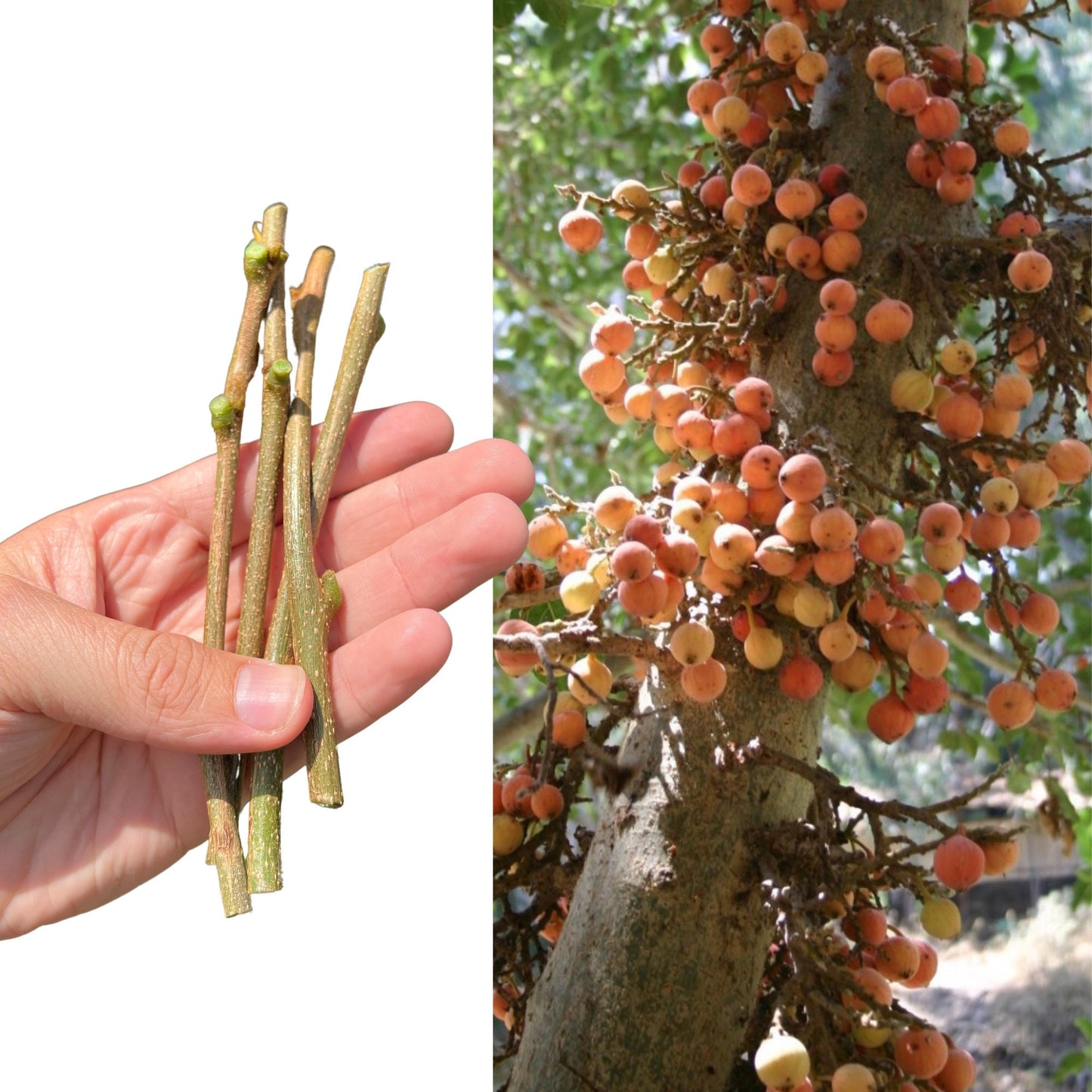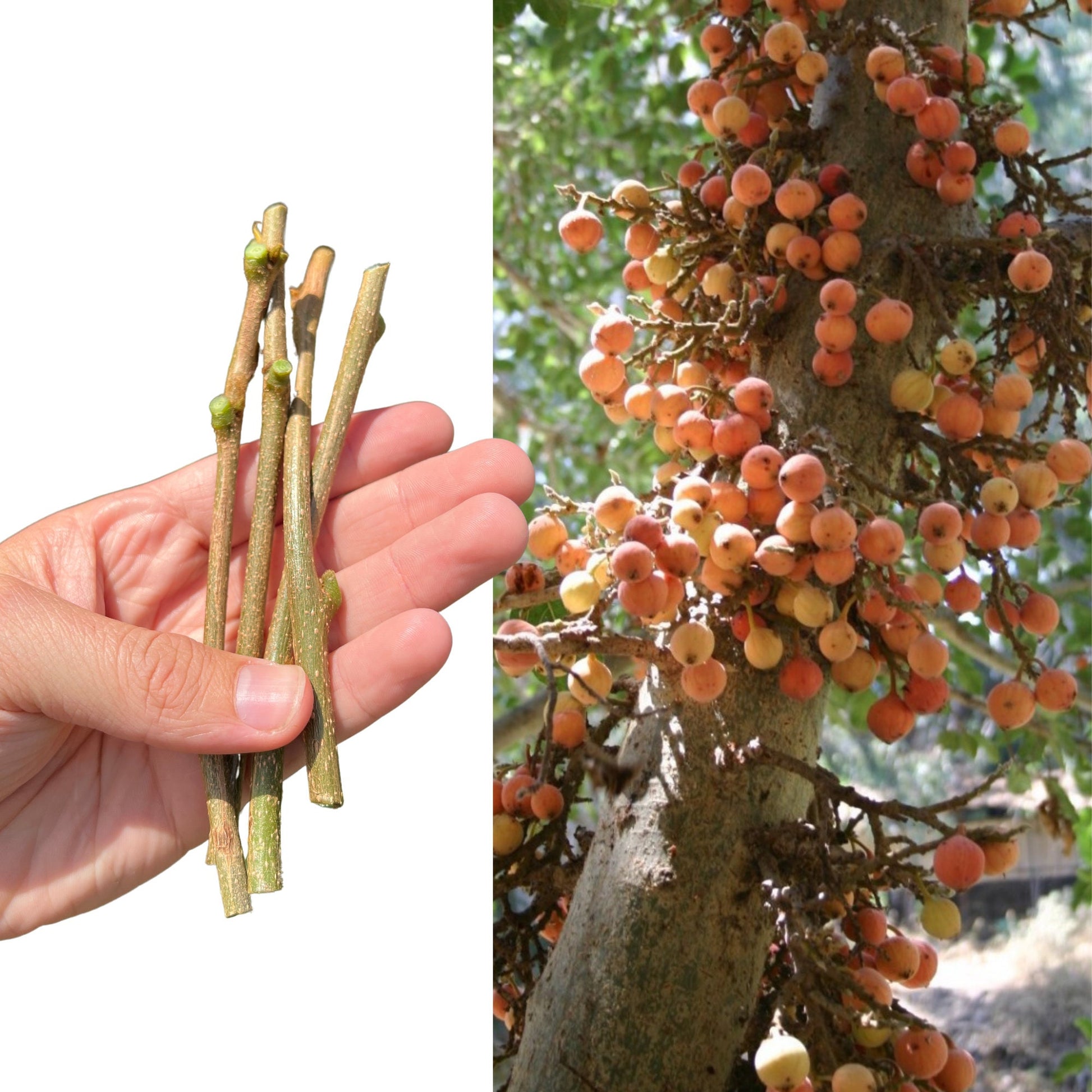Ficus Sycamorus (3 Cuttings) - EXTREMELY RARE - Biblical Fruits
Ficus Sycamorus (3 Cuttings) - EXTREMELY RARE - Biblical Fruits
Couldn't load pickup availability
This is the “Shikma Balami” from Israel, originally imported by a Syrian man named Bass and then brought to Florida by Dr. Steve Brady. It is a parthenocarpic clone meaning it does not require pollination for fruit set and ripening. Ficus carica figs grown in the US are parthenocarpic but in their native region many require wasp pollination for fruit set just like typical forms of Ficus sycamorus.
Ficus sycomorus: The Sycamore Fig
Etymology and Naming The name Ficus sycomorus entered English in the 14th century as "sicamour," derived from Old French sagremore or sicamor, which in turn originated from Latin sycomorus and Ancient Greek σῡκόμορος (sykómoros) meaning 'fig-mulberry.' The Greek name likely derives from sykón ('fig') and moron ('mulberry') or from the Hebrew shiqmah ('mulberry'). The spelling "sycamore" (with an A) has also been used for unrelated trees like Acer pseudoplatanus (great maple) and Platanus species (plane trees), while "sycomore" (with an O) is specifically associated with Ficus sycomorus.
Distribution Ficus sycomorus is native to Africa, from the Sahel to the Tropic of Capricorn, excluding the central-west rainforest regions. It also grows in Lebanon, Cyprus, the southern Arabian Peninsula, Madagascar, Israel, Palestine, and Egypt. The species thrives in rich soils along rivers and in mixed woodlands.
Description This large fig tree reaches 20 meters in height with a dense, round crown and spreading branches. Its heart-shaped leaves, about 14 cm long by 10 cm wide, are dark green above and lighter with yellow veins below. The fruit is a large, edible fig (2–3 cm in diameter), ripening from buff-green to yellow or red, and grows in thick clusters along the branches. The tree flowers and bears fruit year-round, peaking from July to December. The green-yellow to orange bark exfoliates in papery strips, revealing the yellow inner bark. Like all figs, the tree produces latex.
Cultivation Two primary varieties exist in Egypt:
-
Roumi (Falaki or Turki) – Broad, horizontally spreading branches, stouter shoots, denser and wider leaves, and large, flat pink fruits.
-
Kelabi (Arabi or Beledi) – More vertical growth, slender structure, smaller leaves, and yellowish, pear-shaped fruits.
Ancient Egyptians cultivated Ficus sycomorus extensively, with remains found in tombs from the early, middle, and late kingdoms. To induce ripening, they practiced fruit gashing. Despite the extinction of the Ceratosolen arabicus wasp in Egypt (essential for sexual reproduction), Egypt remained a principal region for sycamore fig development.
Historical and Cultural Significance
-
Egypt: Considered the "Tree of Life," Ficus sycomorus played a vital role in Egyptian rituals, with its wood used for mummy caskets and its trees planted around artificial pools in gardens.
-
Israel & the Levant: Introduced by the Philistines during the Iron Age, with historical significance in ancient settlements.
-
Beirut, Lebanon: Formerly abundant in the Gemmayzeh neighborhood, though now largely disappeared.
Religious Significance
-
Judaism & Christianity: Mentioned seven times in the Hebrew Bible and once in the New Testament, where it was a valuable fruit tree in Jericho and Canaan. The "Tree of the Virgin" in Egypt is believed to be a sycamore under which the Holy Family found refuge.
-
Ancient Egypt: Associated with goddesses Hathor, Isis, and Nut, depicted as life-giving trees. Egyptian love poetry references sycamores as meeting places for lovers. The twin sycamores of turquoise in funerary texts symbolized the eastern horizon.
-
Kikuyu Religion (Kenya): The Mugumo tree (Ficus sycomorus) is sacred. Rituals and sacrifices to Ngai (Murungu) were performed under its branches, and its falling was seen as a bad omen.
-
Modern Egyptian Folklore: The tree symbolizes the "Tree of Lifespans," determining the length of one’s life based on the quality of its fruit.
Ficus sycomorus remains an essential ecological and cultural species, revered in multiple traditions and widely cultivated for its fruit and shade.
This is an incredibly rare variety of Ficus and highly sought after from collectors.


